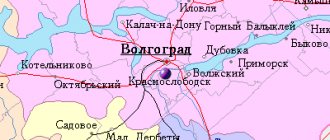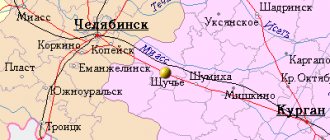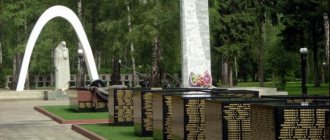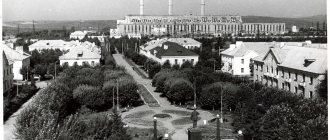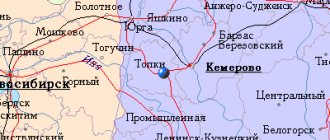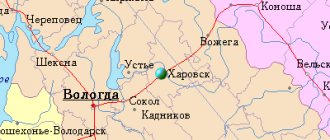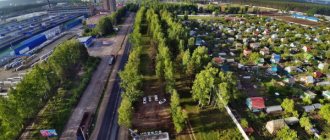This term has other meanings, see Krasnoarmeysk.
| City Krasnoarmeysk Coat of arms |
| A country | Russia, Russia |
| Subject of the federation | Saratov regionSaratov region |
| Municipal district | Krasnoarmeisky |
| urban settlement | Municipal entity Krasnoarmeysk |
| Coordinates | 51°01′00″ n. w. 45°42′00″ E. d. / 51.01667° n. w. 45.70000° E. d. / 51.01667; 45.70000 (G) [www.openstreetmap.org/?mlat=51.01667&mlon=45.70000&zoom=12 (O)] (Z)Coordinates: 51°01′00″ N. w. 45°42′00″ E. d. / 51.01667° n. w. 45.70000° E. d. / 51.01667; 45.70000 (G) [www.openstreetmap.org/?mlat=51.01667&mlon=45.70000&zoom=12 (O)] (I) |
| Based | in 1765 |
| Former names | until 1925 — Naked Karamysh until 1942 - |
| City with | 1918 |
| Center height | 210 |
| Population | ↘23,468[1] people (2016) |
| Names of residents | Red Army soldiers, Red Army soldier |
| Timezone | UTC+3 |
| Telephone code | +7 84550 |
| Postcode | 412800 |
| Vehicle code | 64, 164 |
| OKATO code | [classif.spb.ru/classificators/view/okt.php?st=A&kr=1&kod=63418 63 418] |
| Krasnoarmeysk Moscow |
| Saratov Krasnoarmeysk |
K: Settlements founded in 1765
Krasnoarmeysk
- a city in Russia, the administrative center of the Krasnoarmeysky district of the Saratov region.
Population - 23,468[1] people. (2016).
Story
Founded in 1765 as a colony of German settlers called Balzer
(Balzer).
During the first 2 years, only about 90 families settled in the colony. These were immigrants from Hesse, Palatinate, Isenburg and other German lands and cities. According to the 1768 census, there were 377 people in the colony. The first headman (forestager) of the colony was a peasant from Hesse, Balzer Bartuli, whose name was taken for the name of the colony itself. However, according to the decree of February 26, 1768 “On the names of German colonies”, the colony received the official name Naked Karamysh
[3], where Karamysh is the Turkic word for “muddy, muddy”, and the definition naked indicated the location in a treeless steppe area.
In the middle of the 19th century, it was officially called Naked Karamysh (Balzer).
In 1918, the colony became the center of the Golo-Karamysh district
the newly formed Labor Commune of the Volga Germans, since 1922 - the center of the Golo-Karamysh (Baltser) canton of the Autonomous Soviet Socialist Republic of the Volga Germans.
In 1925, the Naked Karamysh
officially reorganized as the city
of Balzer
.
The city was one of the centers for learning weaving. The training was conducted in a training and demonstration weaving workshop. Upon graduation from this educational institution, graduates were assigned to weaving artels.
On September 7, 1941, after the liquidation of the Autonomous Soviet Socialist Republic of the Volga Germans, the city became the administrative center of the Baltser district as part of the Saratov region[4].
In May 1942, the city of Balzer
was renamed
Krasnoarmeysk
in honor of the Red Army.
On February 1, 1963, the city of Krasnoarmeysk was classified as a city of regional subordination[5].
Krasnoarmeysk
(Saratov region)
OKATO code:
63222501
Founded:
1766
City since:
1918 City of district subordination (Krasnoarmeysky district, Saratov region)
Center:
Krasnoarmeysky district
The city was formerly called:
| Naked Karamysh | 1926 | |
| Balzer | 1926 | 1942 |
| Telephone code (reference phone) | |
| 84550***** | 22-0-83 |
Deviation from Moscow time, hours:
1
Geographic latitude:
51°01′
Geographic longitude:
45°42′
Altitude above sea level, meters:
210 Sunrise and sunset times of the Sun and Moon in the city of Krasnoarmeysk
Industry
There are factories in the city: weaving (closed), sewing, knitting (closed); factories: mechanical (closed), oil mill (closed), ceramic (until 2002 - brick). The ceramic (formerly brick) factory owns a narrow-gauge railway. It can be considered one of the main attractions of the city. This is the only narrow-gauge railway in the Saratov region; as of 2006, it operates a unique home-made locomotive that transports clay from the quarry to the processing workshop.
Religion in Krasnoarmeysk
The majority of the ethnic population of the city professed reformism, a small part - Lutheranism. At the end of the 18th century, a Protestant parish appeared here, and in 1856 the parish of Baltzer was formed.
In the first years, religious services were held in a residential building, and in 1777 a wooden church appeared here. In 1821, another wooden church was built using donations from local craftsmen.
However, two small churches were not enough for all the believers, so a decision was made to build a new church, which began in 1849.
The church was built from local bricks, and the first service was held in it in 1851, and in 1856 it received parish status. In 1924, the church was reconstructed, the roof was covered with iron, funds for this were sent by people from Belzer who lived in the USA.
Unfortunately, in 1931, by order of the Communist Party, the prayer house was first closed, and in 1935, church services were stopped in the church, and a school was opened in the church itself.
The educational institution did not last long; in 1936 it was recognized as unsuitable for a school and was dismantled into bricks.
Attractions
In the city there is a monument to the revolutionary V. T. Smolyaninov, a branch of the Museum of Local History.
Unique ancient houses made of red brick made of local clay - the recipes for the mortar of their masonry are still not known.
Children's summer recreation center in an oak grove - not far from the bank of the Volga River, on the site of the former count's estate
with the children’s favorite, stunning size and geometry, domed structure of the “Count” spring.
The width of the Volga River near the former merchant village of Zolotoe
(called barge haulers after the place of payment) reaches 19.6 kilometers when the Volzhskaya Hydroelectric Power Station dam is blocked.
- Evangelisch-lutherische Kirche Balzer Baujahr 1851 Foto ca 1931.jpg
Lutheran Church, built in the town of Baltser, Kamyshin district, Saratov province in 1851. Destroyed in the 20th century.
- Balzer Amtsgebaeude 2000.jpg
An administrative building built in Balzer in the 19th century.
- Balzer Textilfabrik 2000.jpg
Textile factory building built in the 19th century.
Coat of arms of the city of Krasnoarmeysk (1987 - 2004)
Coat of arms of Krasnoarmeysk: “The heraldic shield is divided into two parts, characterizing the historically established features of the city: northern (blue field) and southern (red field). On the top field there is a stylized image of a land meter - a symbol of industrial enterprises in the northern part of the city. At the bottom is a bobbin, a symbol of the oldest industry in the southern part of the city. The heraldic shield is bordered by a gold stripe, on the upper wider part is the word “Krasnoarmeysk”.
Author:
German Yakovlevich Demin.
Approved August 13, 1987
Date modified: 07/21/2021 11:07
An excerpt characterizing Krasnoarmeysk (Saratov region)
“Yes, go, go, tell me to cook,” she said, pouring out. Boris quietly walked out the door and followed Natasha, the fat boy angrily ran after them, as if annoyed at the frustration that had occurred in his studies. Of the young people, not counting the countess's eldest daughter (who was four years older than her sister and already behaved like a grown-up) and the young lady's guest, Nikolai and Sonya's niece remained in the living room. Sonya was a thin, petite brunette with a soft gaze, shaded by long eyelashes, a thick black braid that wrapped around her head twice, and a yellowish tint to the skin on her face and especially on her bare, thin, but graceful, muscular arms and neck. With the smoothness of her movements, the softness and flexibility of her small limbs, and her somewhat cunning and reserved manner, she resembled a beautiful, but not yet fully formed kitten, which would become a lovely little cat. She apparently considered it decent to show participation in the general conversation with a smile; but against her will, from under her long thick eyelashes, she looked at her cousin [cousin] who was leaving for the army with such girlish passionate adoration that her smile could not deceive anyone for a moment, and it was clear that the cat sat down only to jump more energetically and play with your sauce as soon as they, like Boris and Natasha, get out of this living room. “Yes, ma chere,” said the old count, turning to his guest and pointing to his Nicholas. - His friend Boris was promoted to officer, and out of friendship he does not want to lag behind him; he leaves both the university and me as an old man: he goes into military service, ma chere. And his place in the archive was ready, and that was it. Is that friendship? - said the count questioningly. “But they say war has been declared,” said the guest. “They’ve been saying this for a long time,” said the count. “They’ll talk and talk again and leave it at that.” Ma chere, that’s friendship! - he repeated. - He is going to the hussars. The guest, not knowing what to say, shook her head. “Not out of friendship at all,” answered Nikolai, flushing and making excuses as if from a shameful slander against him. – Not friendship at all, but I just feel a calling to military service. He looked back at his cousin and the guest young lady: both looked at him with a smile of approval. “Today, Schubert, colonel of the Pavlograd Hussar Regiment, is dining with us. He was on vacation here and takes it with him. What to do? - said the count, shrugging his shoulders and speaking jokingly about the matter, which apparently cost him a lot of grief. “I already told you, daddy,” said the son, “that if you don’t want to let me go, I’ll stay.” But I know that I am not fit for anything except military service; “I’m not a diplomat, not an official, I don’t know how to hide what I feel,” he said, still looking with the coquetry of beautiful youth at Sonya and the guest young lady. The cat, glaring at him with her eyes, seemed every second ready to play and show all her cat nature. - Well, well, okay! - said the old count, - everything is getting hot. Bonaparte turned everyone’s heads; everyone thinks how he got from lieutenant to emperor. Well, God willing,” he added, not noticing the guest’s mocking smile. The big ones started talking about Bonaparte. Julie, Karagina’s daughter, turned to young Rostov: “What a pity that you weren’t at the Arkharovs’ on Thursday.” “I was bored without you,” she said, smiling tenderly at him. The flattered young man with a flirtatious smile of youth moved closer to her and entered into a separate conversation with the smiling Julie, not noticing at all that this involuntary smile of his was cutting the heart of the blushing and feignedly smiling Sonya with a knife of jealousy. “In the middle of the conversation, he looked back at her. Sonya looked at him passionately and embitteredly and, barely holding back the tears in her eyes and a feigned smile on her lips, she stood up and left the room. All Nikolai's animation disappeared. He waited for the first break in the conversation and with an upset face left the room to look for Sonya. – How the secrets of all these young people are sewn with white thread! - said Anna Mikhailovna, pointing to Nikolai coming out. “Cousinage dangereux voisinage,” she added. “Yes,” said the countess, after the ray of sunshine that had penetrated into the living room with this young generation had disappeared, and as if answering a question that no one had asked her, but which constantly occupied her. - How much suffering, how much anxiety has been endured in order to now rejoice in them! And now, really, there is more fear than joy. You're still afraid, you're still afraid! This is precisely the age at which there are so many dangers for both girls and boys. “Everything depends on upbringing,” said the guest. “Yes, your truth,” continued the Countess. “Until now, thank God, I have been a friend of my children and enjoy their complete trust,” said the countess, repeating the misconception of many parents who believe that their children have no secrets from them. “I know that I will always be the first confidente [confidant] of my daughters, and that Nikolenka, due to her ardent character, if she plays naughty (a boy cannot live without this), then everything is not like these St. Petersburg gentlemen. “Yes, nice, nice guys,” confirmed the count, who always resolved issues that confused him by finding everything nice. - Come on, I want to become a hussar! Yes, that's what you want, ma chere! “What a sweet creature your little one is,” said the guest. - Gunpowder! “Yes, gunpowder,” said the count. - It hit me! And what a voice: even though it’s my daughter, I’ll tell the truth, she will be a singer, Salomoni is different. We hired an Italian to teach her. - Is not it too early? They say it is harmful for your voice to study at this time. - Oh, no, it’s so early! - said the count. - How did our mothers get married at twelve thirteen? - She’s already in love with Boris! What? - said the countess, smiling quietly, looking at Boris’s mother, and, apparently answering the thought that had always occupied her, she continued. - Well, you see, if I had kept her strictly, I would have forbidden her... God knows what they would have done on the sly (the countess meant: they would have kissed), and now I know every word she says. She will come running in the evening and tell me everything. Maybe I'm spoiling her; but, really, this seems to be better. I kept the eldest strictly. “Yes, I was brought up completely differently,” said the eldest, beautiful Countess Vera, smiling. But a smile did not grace Vera’s face, as usually happens; on the contrary, her face became unnatural and therefore unpleasant. The eldest, Vera, was good, she was not stupid, she studied well, she was well brought up, her voice was pleasant, what she said was fair and appropriate; but, strangely, everyone, both the guest and the countess, looked back at her, as if they were surprised why she said this, and felt awkward. “They always play tricks with older children, they want to do something extraordinary,” said the guest. - To be honest, ma chere! The Countess was playing tricks with Vera,” said the Count. - Well, oh well! Still, she turned out nice,” he added, winking approvingly at Vera. The guests got up and left, promising to come for dinner. - What a manner! They were already sitting, sitting! - said the countess, ushering the guests out. When Natasha left the living room and ran, she only reached the flower shop. She stopped in this room, listening to the conversation in the living room and waiting for Boris to come out. She was already beginning to get impatient and, stamping her foot, was about to cry because he was not walking now, when she heard the quiet, not fast, decent steps of a young man.
History of the Krasnoarmeysky district of the Saratov region
In the second half of the 16th century, as a result of repeated military campaigns in the Volga region during the reign of Ivan the Terrible, the territory annexed to Russia. The settlement along the Volga River and in the forests of fugitive peasants, convicts, various servicemen, and townspeople, who sought freedom from serfdom on the remote outskirts, dates back to this time.
Mass settlement of the territory begins thanks to the colonization policy begun by Peter I at the beginning of the 18th century and continued by Catherine II. By the second half of the 18th century. attributed to the emergence of many settlements that are part of the region today.
The decrees of Empress Catherine II of 1762, 1763, 1764 read:
“We allow all foreigners to enter Our Empire and settle wherever they wish, in all our provinces.” The decrees of Catherine II attracted hundreds of immigrants from Prussia, Saxony, France, and Switzerland.
From the very beginning, the government of Catherine II provided immigrants with unprecedented preferential conditions for relocation, settlement and settlement. The settlers were exempt from many taxes and from conscription for military service. The settlers belonged to various social groups, but mostly they were poor people. The first batch of migrants who arrived in Saratov were divided into groups and sent down the Volga, placing them for residence on the right bank south of Saratov. The emergence of the settlements of Frantsuzen (1765), today the village of Rossosha, dates back to this time; Anton (1764), today the village of Sadovoye; Shilling (1764), today the village of Sosnovka; Gukk (1767), today Splavnukha; Baidek (1764), today the village of Luganskoe; Messer (1766), today Ust-Zolikha; Mink (1767), today the village of Nekrasovo; Grimm (1765), today the village of Kamensky; Moore (1766), today p. Keys; village Kamenka (1765); Wauer (1766), today the village of Karamyshevka, Gusary (1766), today the village of Elshanka, Kutter (1767), as well as Baltser (1765), now the city of Krasnoarmeysk.
It is necessary to point out that in this territory the existence of Russian villages, such as the village, dates back to this time. Zolotoye (beginning of the 18th century), p. Pryakhino (18th century), p. Revino (c. 19th century - 19th century), p. Rogatkino (beginning of the 19th century), p. Topovka (second half of the 18th century), the village of Melovoe (part of the 18th century), the village. Mordovoye (mid-XVIII century), p. Belogorskoye (at the turn of the XVIII-XVIII centuries), village. Gusevo (beginning of the 18th century), p. Vaulino (early 19th century), p. Bobrovka (half a quarter of the 18th century).
On the site of the city of Krasnoarmeysk, a village was designed, in which about 90 families could initially settle. The first fortress in the colony was Baltser Bartuli, and it got its name from him. In 1788, 99 families lived in the colony, with a total of 682 people; in 1886, the population numbered 695 families and amounted to 5,760 inhabitants.
In the middle of the 19th century. An oil mill for processing sunflower was founded. At the beginning of the twentieth century. this production became a factory, after the revolution of 1917 it was given the name “Spartak”.
In 1884, an iron foundry began operating in the city, which became the basis for. In 1986, 300 people worked in its workshops.
Approximately in 1870 (sources are not fully verified), a brick factory was opened in the city with manual molding of bricks and firing them in floor ovens with wood. It was from this time that buildings made of red brick and mosaic masonry appeared in the city.
At the beginning of the 20th century, one of the first weaving finishing factories for the production of sarpinka was opened in Balzer. Its owner was Andrey Bender.
In the center of the city today there is a factory building built by an entrepreneur, the buildings of which served the Nizhne-Volzhsky trust created in the 20s, then the factory named after. K. Zetkin. Bender built a mansion for himself, in which he almost never lived, but only visited from Saratov.
In 1918, the village of Goly Karamysh became the center of the Golo-Karamysh district, and in the same year it received the status of a city.
The turbulent revolutionary events were fully reflected in the development of the Krasnoarmeysky region. At the beginning of 1918, the Union of Socialist Internationalists was formed in Saratov, which was engaged in organizing self-government of Germans in the Lower Volga region. The signing of the Brest-Litovsk Treaty, the policy of the Soviet state on the issue of the right of nations to self-determination, the initiative of the population itself led to the fact that in April 1918 a commissariat for German affairs was organized in Saratov, and then, according to the Decree of the Council of People's Commissars of October 19, 1918, an autonomous region was formed Germans of the Volga region, which included from the Saratov province the corresponding parts of Kamyshinsky and Atkarsky districts. In 1922, during the so-called “rounding,” a number of volosts, including Zolotovskaya, Bannovskaya, Topovskaya, and Akhmatskaya, became part of the region of the Volga Germans.
In 1923, the Lower Volga Textile Trust was organized in the city of Goly Karamysh, thereby preparatory work was carried out for the creation of state enterprises. In 1925, the factory named after K. Zetkin was opened, in 1926 - the factory named after K. Liebknecht. At this time, the oil mill and repair and mechanical plant “Rabochiy” were significantly improved, a potash plant was opened, and the production volumes of the brick plant were increased. In 1931, the newspaper Leninsch weg (in German) was published in Balzer, and since 1932 the newspaper “Leninsky Put” (in Russian).
In the 1930s, a paramedic-midwife school and the Balzer German collective and state farm theater were opened in the city. At this time, the city already had 7 primary, seven-year and secondary schools, a city park, a club of young pioneers, and libraries. In the vicinity of the city, a landing site was equipped for an aircraft serving the first postal and passenger airline in the ASSRNP.
With the beginning of the Great Patriotic War, on the basis of the Decree of the Presidium of the Supreme Soviet of the USSR of August 28, 1941, the German population was evicted to Siberia and Kazakhstan, and in May 1942, all settlements with German names were renamed. And at the same time, the evacuation of residents of the western regions of the USSR began to the territory of the region.
Thus, the Kiev Knitting Factory and the Weaving Factory from the city of Vyshny Volochek, evacuated to the city, joined the light industry factories. In 1964, the liquidated city industrial plant merged with the K. Zetkin factory. At the same time, in the 60s, 800 units of sewing equipment were installed at the factory’s production sites, and 50 thousand pieces of more than 100 items rolled off the assembly line every day.
In 1965, the K. Liebknecht factory produced more than 25 million linear meters of fabric, i.e. 86 thousand meters per day.
In 1966, the reconstruction of the municipal food processing plant was completed, and a new brick building was built. In 1962, a garment factory was put into operation. At the end of the 50s, a drilling office was opened in the city.
In 1958, the first cobblestone streets appeared in the city, and construction of a water pipeline began. Since the 1960s, gasification of the city with natural gas began. Throughout the 60-90s, administrative changes and changes in the management of the territory took place in the Krasnoarmeysky region.
In 1964, the Krasnoarmeysky regional executive committee was organized. In 1965, the District Council. In 1965 the District Council was merged with the City Council. In May 1984, the division into city and district councils took place again. An important event for the region was the decision made in 1978 to build the Krasnoarmeyskselmash plant. The construction was declared an all-Union shock Komsomol construction project. In connection with the construction of the plant, the architectural appearance of the city is changing, a residential microdistrict of five-story buildings is being built, as well as adjacent socio-cultural facilities.
